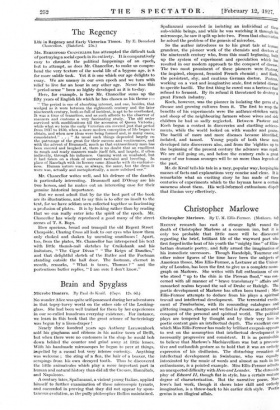Brain and Spyglass
Microbe Hunters. By Paul do Kruif. (Cape. 12s. 6d.)
No wonder Alice was quite self-possessed during her adventures in that topsy-turvy world on the other side of the Looking- glass. She had been well trained for them by her experiences in our so-called humdrum everyday existence. For instance, we learn in this book that the great science of bacteriology was begun by a linen-draper !
Nearly three hundred years ago Anthony Leeuwenhoek sold his ginghams and ribbons in his native town of Delft, but when there were no customers in the shop he would bob down behind the counter and grind away at little lenses. With his handmade microscopes he began to peer at things, impelled by a casual but very intense curiosity. Anything was welcome ; the sting of a flea, the hair of a beaver, the scrapings from his own decayed tooth. Thus he discovered the little animalcules which play a more important part in human and natural history than did all the Caesars, Hannibals, and Napoleons.
A century later, Spallanzani, a violent young Italian, applied himself to further examination of these microscopic tyrants, and succeeded in proving that they did not appear by spon- taneous evolution, as the puffy philosopher Buffon maintained.
Spallanzani succeeded in isolating an individual of these sub-visible beings, and while he was watching it through his microscope, he saw it split up into two. From that observation he solved the problem of the genesis of microbes.
So the author introduces us to his great tale of human grandeur, the pioneer work of the chemists and doctors of the nineteenth century who, from this small beginning, built up the system of experiment and speculation which has resulted in our modern approach to the conquest of disease, The two most prominent of these pioneers were Pasteur, the inspired, eloquent, frenzied French chemist ; and Koch, the persistent, - shy, and cautious German doctor. Pasteur, working on a vast and imaginative scale, first related disease to specific bacilli. The first thing he cured was a beetroot that refused to ferment. By its refusal it threatened to destroy great French industry.
Koch, however, was the pioneer in isolating the germ of a disease and growing cultures from it. The first to reap the benefits of his experiments were the anthrax-stricken cattle and sheep of the neighbouring farmers whose wives and sick children he had so sadly neglected. Between Pasteur and Koch began a contest in discoveries and startling achieve- ments, while the world looked on with wonder and praise. The bacilli of more and more diseases became identified, isolated, and tamed. Young pupils of both these men developed into discoverers also, and from the 'eighties up to the beginning of the present century the advance was rapid. We are still going on, and before the century ends a great many of our human scourges will be no more than legends of the past.
Mr. de Kruif tells his tale in a racy, popular way, keeping his masses of facts and explanations very concise and clear. It is remarkable what an exciting story he has made of three centuries of experiments which to the layman have a certain sameness about them. His well-informed enthusiasm dispels that illusion very effectively.










































 Previous page
Previous page